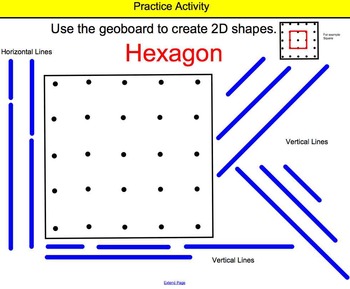2D and 3D Shapes TWO Interactive Smartboard Lessons
Laura Sluss
121 Followers
Resource Type
Standards
CCSSK.G.B.4
CCSSK.G.B.5
CCSSK.G.B.6
CCSS1.G.A.1
CCSS1.G.A.2
Formats Included
- NOTEBOOK (SMARTboard) File
Pages
20 pages
Laura Sluss
121 Followers
Description
This interactive SMARTBOARD activity has two lessons within it. The first lesson allows students to practice identifying and describing 2D and 3D shapes. The second lesson allows students to compose shapes and then make new shapes out of their composed shapes. Make sure you have your students come up to the board to participate. They will especially love self-checking their answers!
Lesson Objective
Students will be able to identify 2D and 3D shapes and their attributes.
Students will be able to compose 2D and 3D shapes and then compose a new shape from the composite shape.
Common Core Standard Alignment
1st Grade: Geometry: Reason with shapes and their attributes.
1. Distinguish between defining attributes (e.g., triangles are closed and three-sided) versus non-defining attributes(e.g., color, orientation, overall size); build and draw shapes to possess defining attributes.
2. Compose two-dimensional shapes (rectangles, squares, trapezoids, triangles, half circles, and quarter-circles) or three-dimensional shapes (cubes, right rectangular prisms, right circular cones, and right circular cylinders) to create a composite shape, and compose new shapes from the composite shape.
Materials Included
- 2 Smartboard Lessons on 2D and 3D shapes
Additional Needed Materials
- Don’t forget to download the companion 2D and 3D practice worksheets and assessments. These two items are tied together and will provide you with an interactive and comprehensive lesson on shapes.
Lesson Objective
Students will be able to identify 2D and 3D shapes and their attributes.
Students will be able to compose 2D and 3D shapes and then compose a new shape from the composite shape.
Common Core Standard Alignment
1st Grade: Geometry: Reason with shapes and their attributes.
1. Distinguish between defining attributes (e.g., triangles are closed and three-sided) versus non-defining attributes(e.g., color, orientation, overall size); build and draw shapes to possess defining attributes.
2. Compose two-dimensional shapes (rectangles, squares, trapezoids, triangles, half circles, and quarter-circles) or three-dimensional shapes (cubes, right rectangular prisms, right circular cones, and right circular cylinders) to create a composite shape, and compose new shapes from the composite shape.
Materials Included
- 2 Smartboard Lessons on 2D and 3D shapes
Additional Needed Materials
- Don’t forget to download the companion 2D and 3D practice worksheets and assessments. These two items are tied together and will provide you with an interactive and comprehensive lesson on shapes.
Total Pages
20 pages
Answer Key
Does not apply
Teaching Duration
1 Week
Report this resource to TPT
Reported resources will be reviewed by our team. Report this resource to let us know if this resource violates TPT’s content guidelines.
Standards
to see state-specific standards (only available in the US).
CCSSK.G.B.4
Analyze and compare two- and three-dimensional shapes, in different sizes and orientations, using informal language to describe their similarities, differences, parts (e.g., number of sides and vertices/“corners”) and other attributes (e.g., having sides of equal length).
CCSSK.G.B.5
Model shapes in the world by building shapes from components (e.g., sticks and clay balls) and drawing shapes.
CCSSK.G.B.6
Compose simple shapes to form larger shapes. For example, “Can you join these two triangles with full sides touching to make a rectangle?”
CCSS1.G.A.1
Distinguish between defining attributes (e.g., triangles are closed and three-sided) versus non-defining attributes (e.g., color, orientation, overall size); build and draw shapes to possess defining attributes.
CCSS1.G.A.2
Compose two-dimensional shapes (rectangles, squares, trapezoids, triangles, half-circles, and quarter-circles) or three-dimensional shapes (cubes, right rectangular prisms, right circular cones, and right circular cylinders) to create a composite shape, and compose new shapes from the composite shape.





